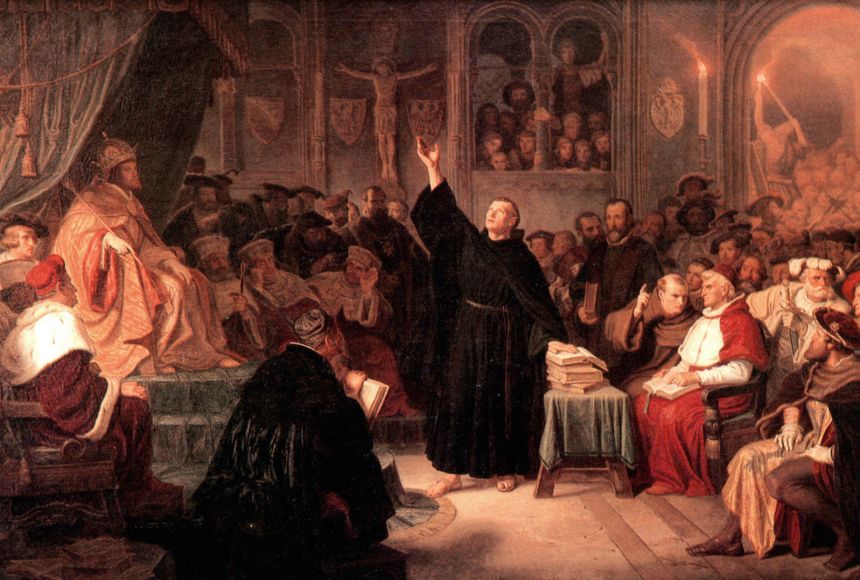The Protestant Reformation was a religious reform movement in Europe in the 1500s. A reform movement seeks to change some part of society. The Protestant Reformation resulted in the creation of a new kind of Christian religion called Protestantism. It includes many religious groups that separated from the Roman Catholic Church due to differences in their beliefs.
Originated in Germany on Halloween
The Protestant Reformation began in Wittenberg, Germany, on October 31, 1517. Martin Luther, a teacher and a monk, started the movement. He published a document he called Disputation on the Power of Indulgences, or 95 Theses. The document was a series of 95 ideas about Christianity that he invited people to debate with him. These ideas caused a great deal of debate because they directly went against the Catholic Church's teachings.
Luther's statements challenged the Catholic Church's role as the middleman between people and God. He specifically challenged the indulgence system. The indulgence system allowed people to buy a certificate of pardon for their sins. Luther argued against the practice of buying or earning forgiveness, believing instead that salvation is a gift God gives to those who have faith.
Luther's objections to the indulgence system led to other challenges to Catholic beliefs by himself and others throughout Europe. For example, John Calvin, in France, and Huldrych Zwingli, in Switzerland, proposed their own new ideas. A group called Anabaptists rejected the idea that infants should be baptized. They favored the idea that baptism was reserved for adult Christians.
Cutting Out the Middleman
Broadly speaking, most of the challenges to the Catholic Church revolved around one core idea. It was the notion that individual believers should be less dependent on the Catholic Church's pope and priests. Instead, Protestants believed people should have an independent relationship with God. They wanted people to take personal responsibility for their faith and refer directly to the Bible, the Christian holy book, for worship and wisdom.
In England, Protestant reform began with Henry VIII in 1534, because the pope would not allow him to cancel his marriage. That led King Henry to reject the pope's authority, instead creating and taking authority over the Church of England himself. He created a mixed-belief church that combined some Catholic beliefs and some Protestant ideals.
Over the next 20 years, there was religious turbulence in England. Queen Mary, who lived from 1516 to 1558, reinstated Catholicism in the country. She oppressed and kicked out Protestants. Later, Queen Elizabeth I and her Parliament attempted to lead the country back toward Protestantism during her reign from 1558 to 1603.
Some English citizens did not believe Queen Elizabeth's efforts to restore England to Protestantism went far enough. These citizens fell into two groups, both labeled Puritans by their opponents. The first group, known as separatists, believed the English church was so dishonest that their only choice was to leave England, separate from the church, and start a new church. They called this the English Separatist Church.
Separatists and Puritans
Around 1607 or 1609, some of the separatists tried to start the new lives they imagined in Holland, in the Netherlands. Ultimately, the plan failed. They faced poverty and felt that their children were becoming part of Dutch culture instead of English. Many of the Separatists returned to England.
By 1620, members of the English Separatist Church were ready for a second try at establishing a new life and church. Those who set sail aboard the Mayflower for New England eventually landed near Plymouth, Massachusetts. They would, over time, become known as the Pilgrims.
The other group of English citizens who did not believe Queen Elizabeth's reform efforts went far enough were called nonseparatists. Over time, they would be called Puritans. They did not seek to leave the Church of England. They wanted only to reform it by getting rid of the parts of Catholicism that remained within it.
The Puritans did not desire to separate from the Church of England. However, some of them saw moving to New England as their best chance at true reform of the church and freedom to worship as they chose. In 1630, a decade after the Pilgrims embarked on a similar journey for similar reasons, the first Puritans traveled to the New World. They established the Massachusetts Bay Colony in Boston, Massachusetts.
Though the Separatists and nonseparatists disagreed about whether to cut ties to the Church of England, both groups of early North American colonists were unhappy with the church. They both felt they were free to start a church more in line with their beliefs. This freedom to practice religion according to one's beliefs led to the creation of countless different churches and beliefs in the colonies. This wide variety of ideas has also led to disagreements.
Core American Value
This variety of religious thought has also become a core value of the United States. The first 10 amendments to the United States Constitution are called the Bill of Rights. It specifically says that the U.S. government cannot have an official religion and it also cannot stop people from following their preferred religious practices. Over 400 years in the making, this belief in personal empowerment and religious independence has its roots in the Protestant Reformation. It has become an enduring part of the American mindset.

